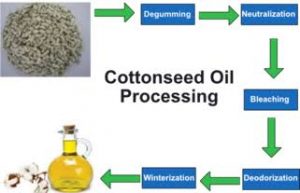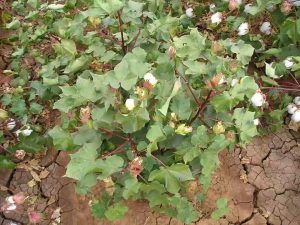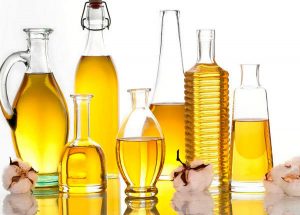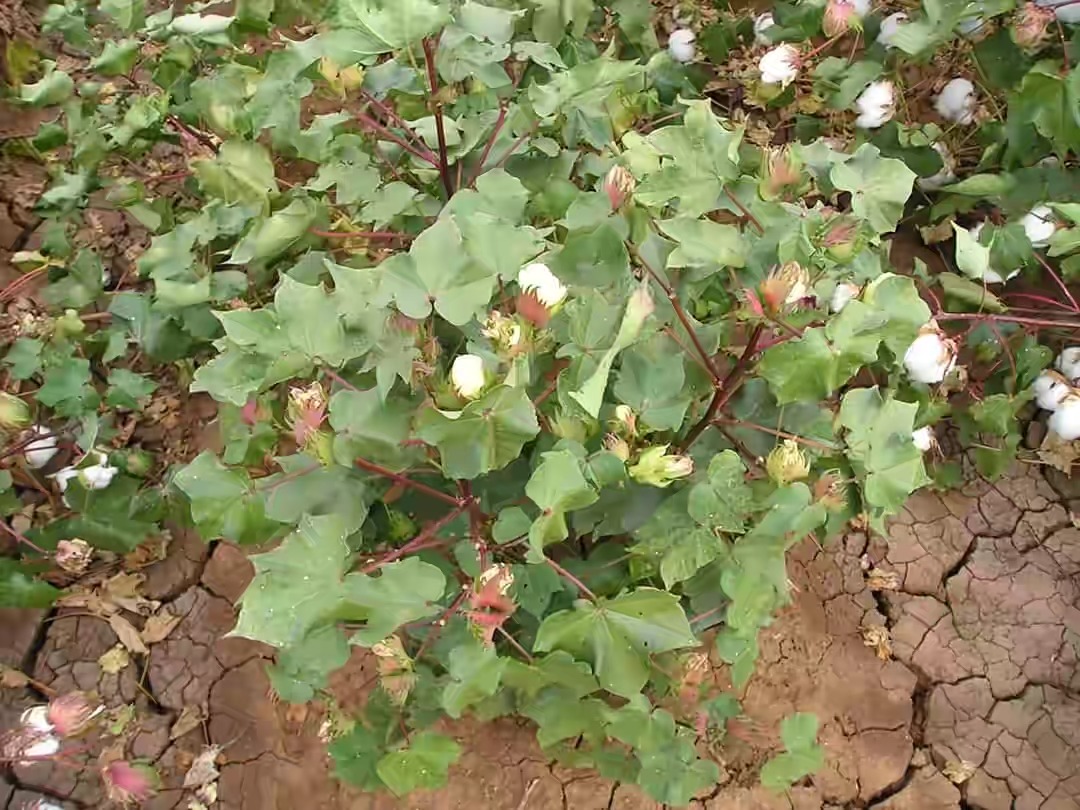Gossypium or Cotton or Auduga (Hausa) or Ewe-owu (Yoruba) or Shimbi (Bogghom): A plant not only for the textile industry but also with numerous health benefits and medicinal properties.
How to make oil from cotton seed
The processing of cotton seed oil involves a series of steps including heating, addition of sodium hydroxide, bleaching with clay, filtering and treating with steam under vacuum.

Source: Wikipedia
Cotton seed oil has been in common use since the middle of the nineteenth century and achieved GRAS (Generally Recognised As Safe) status under the United States Federal Food Drug and Cosmetic Act because of its common use prior to 1958.
Health Benefits and Medicinal Uses of Cotton seeds, leaves, roots and oil
NUTRITION AND ETHNOMEDICINE: The seeds are edible and contain up to 40% protein, they have a nutty flavour when roasted and can be eaten as a snack. They are also boiled and used like rice in casseroles and soups. Ground into a powder, they can be added to flour when making bread, cakes etc.
They can also be made into a spread similar to peanut butter. Some forms of this plant produce seeds containing the toxin gossypol, which needs to be removed before the seed is eaten. The seeds of glandless cultivars do not contain this toxin.
The oil is used in shortening, margarine, salad and cooking oils, and for protective coverings. De-linted cotton seed (i.e. seed with no lint or linters) is processed into oil, meal and hulls.
It is used in a variety of products including edible vegetable oils and margarine, soap, and plastics. Cotton seed meal is the product remaining once the oil has been removed by crushing and can contain up to contain 41% protein.
Cotton seed, or meal, flour or hulls derived from it, is used in food products and for animal feed, but this is limited by the presence of natural toxicants in the seeds (gossypol and cyclopropenoid fatty acids.
Cotton seed meal has been approved for use in human food in the USA and other countries, when derived from gossypol-free varieties of cotton or after processing to remove the gossypol.
The FAO and WHO permit up to 0.6 μg/mg (600 ppm) free gossypol in edible cotton seed products, whereas the FDA has a lower limit of 450 ppm. Human consumption of cotton seed meal is reported mainly in Central American countries and India where it is used as a low cost, high quality protein ingredient.
Other Health Benefits
Cottonseed is rich in vitamins of the B-Complex (thiamine, riboflavin, nicotinic acid, pantothenic acid, pyridoxine, biotin, inositol and folate).
Leaf extracts from G. barbadense have been used in traditional medicine in Inagua (Bahamas, USA) to cure ‘proud flesh’ (swollen tissue around a wound), and for nausea during pregnancy.

Currently, G. barbadense extracts are sold for use in alternative medicine for treatment of hypertension, fungal infections, and as an abortifacient or emmenagogue (menstruation stimulant).
Extracts from G. barbadense have been shown to have anti-hypertensive effects in rats and to increase smooth muscle contraction in guinea pigs.
Gossypol has also been studied for its use as a treatment for cancer.
Gossypol has also been investigated as a human contraceptive, and shown to be highly effective, although it has irreversible effects in approximately 20% of men. It has also been investigated as an anti-parasitic agent.
Experiments have shown that gossypol reduces the growth of both Trypanosoma cruzi, the causal agent of Chagas disease and Entamoeba histolytica, which causes amoebiasis.
In Guinea, leaves and seeds considered emollient and roots emmenagogue. About 100 g root is boiled in about a liter of water until reduced by 1/2. Fifty g of the resultant witches brew is then drunk about every half hour.
Root decocotion is used for asthma, diarrhea, and dysentery.
Root bark, devoid of tannin, astringent, antihemorrhoidal; used as an emmenagogue, hemostat, lactagogue, oxytocic, parturient, and vasoconstrictor.
In Unani system of medicine, cotton seeds of Gossypium herbaceum are useful in inadequate lactation, cough, bronchial asthma, sexual debility, general weakness, diabetes, hysteria, lung and skin diseases.
The flour of seed is five times more tonic than wheat flour and two and half times more than meat.
Water (juice) of leaves is useful in childhood diarrhoea.
Paste of leaves with rose oil is useful in gout. The powder of leaves is useful to stop bleeding from the wound.
Generally, in ethno-medicine, the seeds of Gossypium herbaceum are useful as a nervine tonic in headache and brain affections, and decoctions of the seeds are given in dysentery and intermittent fever.
The seeds in the form of emulsion are given in dysentery. Pounded and mixed with ginger and water they are applied for the treatment of orchitis.
The seeds in the form of poultice make a good application to burns and scalds.
Cotton seed oil is useful in clearing the skin of spots and freckles. The juice of the leaves is useful in dysentery.

The leaves externally in the form of poultice hasten the maturation of boils and with oil they are applied as a plaster to gouty joints.
Root bark of Gossypium herbaceum and leaves of Bambusa arundinacea are mixed together and given with water to induce abortion (DO NOT PRACTISE THIS!) as well as to speed up labour (child delivery).
FOR FURTHER READING SEE:
1. Bhat, R.B., Etejere, E.O. & Oladipo, V.T., 1990. Ethnobotanical studies from Central Nigeria. Economic Botany 44(3): 382-390.
2. David, O.M. & Falegan, C.R., 2007. Effect of fermentation on physicochemical and antibacterial activity of cottonseed oil. Journal of Pure and Applied Microbiology 1(2): 181-184.
3. Dowd, M.K., 2011. Cottonseed oil. In: Gunstone, F.D. (Editor). Vegetable oils in food technology: composition, properties and uses. 2nd Edition. Blackwell Publishing, Oxford, United Kingdom. pp. 199-224.
4. ICAC, 2008. Cotton production practices. International Cotton Advisory Committee, Washington D.C., United States.
5. Lukonge, E., Labuschange, M.T. & Hugo, A., 2007. The evaluation of oil and fatty acid composition in seed of cotton from various countries. Journal of the Science of Food and Agriculture 87(2): 340-347.
6. Opondo, R.M., Ombakho, G.A. & Okiyo, T.O., 1996. Yield improvement in upland cotton by hybridization and selection. In: Focus on Agricultural Research for Sustainable Development in a Changing Economic Environment. Proceedings of the 5th KARI Scientific Conference, Nairobi, Kenya. 14-16, October, 1996. (pp. 637-644).
Prof Sa’eed Halilu Bawa
























